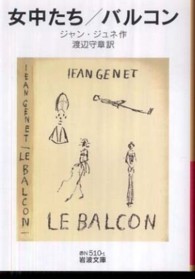Full Description
This volume focuses on the singing voice in contemporary cinema from 1945 to the present day, and rather than being restricted to one particular genre, considers how the singing voice has helped define and/or confuse genre classification. Typically heard in song, the singing voice is arguably the most expressive of all musical instruments. This volume celebrates the ways in which singing features in film. This includes the singing voice as protagonist, as narrator, as communicator, as entertainer, and as comedic interlude. Whether the singing voice in film is personally expressive, reflexive and distant, or synchronized for entertainment, there is typically interplay between the voice and visual elements. Extending beyond the body of literature on 'the musical', the volume is not about musicals per se. Rather, The Singing Voice in Contemporary Cinema discusses the singing voice as a distinct genre that focuses on the conceptualization and synchronization of the singing voice in the post-War era. It explores the relationship between screen, singing, singer and song; it celebrates the intersection of the singing voice and popular culture. In doing so, the volume will cross multiple disciplines including vocal studies, film studies, film sound studies, and music production (vocal processing).
Contents
1. The Singing Voice in Contemporary Cinema
Diane Hughes and Mark Evans
2. Singing, Sonic Authenticity and Stardom in Dancer in the Dark
Nessa Johnston, Edge Hill University
3. Find Your Voice: Narratives of Women's Voice Loss in American Cinema
Katherine Meizel, Bowling Green State University
4. Singing a Life in Bondage: Black Vocality and Subjectivity in 12 Years A Slave
Gianpaolo Chiriacò, Universität Innsbruck
5. Ghost Singers: The Singing Voice in Korean Pop Cinema
Sarah Keith and Alex Mesker, both at Macquarie University
6. Voices of Sheila: Re-signification in Bollywood Filmic and Non-filmic Contexts
Nina Menezes, University of Tampa
7. Before #MeToo: Hearing Vulnerability
Diane Hughes and Mark Evans
8. Trailer Trash or Inspired Vocalization? Song as Promotion and Aesthetic Object in Cinematic Previews
James Deaville and Agnes Malkinson, both at Carleton University
9. 'You've Got a Friend in Me': Singing Voices in the Toy Story Films
Natalie Lewandowski, Independent Researcher, and Penny Spirou, Australian Film, Television & Radio School
10. The Singing Voice and its Use to Evoke Unease, Discomfort and Violence
Liz Giuffre, University of Technology, Sydney, and Mark Thorley, Coventry University
11. The Female Singing Voice: Gospel, Blues, Epic stories and Animation
Anne Power, Western Sydney University
12. From Despicable to Happy: Animated Vocality in the Evolution of Felonius Gru
Veronica Stewart, Sydney Voice Studio, and Diane Hughes








